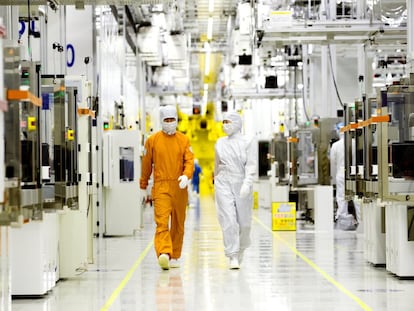Vice president of Advanced Micro Devices Jason Banta: ‘Computers with artificial intelligence will be able to anticipate our needs’
The microchip manufacturer unveils its latest accelerator series in Silicon Valley, with the aim of popularizing smart laptops from 2024 onward


In a hotel in San Jose, California, in the heart of Silicon Valley, Advanced Micro Devices (AMD) launched the next part of the artificial intelligence revolution amidst light shows and euphoric applause. That novelty is the MI300, an accelerator that fits in the palm of a person’s hand, which the Californian company claims will be able to run artificial intelligence software faster than any product currently on the market. “By now we are, perhaps, tired of hearing about artificial intelligence, but it is surely the most transformative technological revolution in the last 50 years, probably even more so than computers and the internet,” Lisa Su, the CEO of AMD, said at the event, to which EL PAÍS was invited in early December.
The MI300 launch is one of the most important in the company’s five-decade history. AMD’s artificial intelligence processors are already being used by the sector’s most important companies and researchers to manufacture computers with integrated AI, including Microsoft, Open AI and Meta. At the end of the event, AMD vice president and general manager, Jason Banta, 44, spoke to EL PAÍS about the possibilities of this technology, which he says is advancing at a “dizzying and exciting” rate.
Question: How is it possible that something that nobody was talking about five years ago has become today’s most important topic?
Answer. One of the most transformative aspects has been large-scale language models. They have been evolving quite rapidly since 2017, and they really gained momentum when a lot of people saw their dazzling beauty and all that they can do. That created a lot of additional interest, whether in chatbots or other generative AI applications. And it’s probably been the fastest development of a new technology that we’ve seen in the industry; it’s become a transformative tool in the cloud, on the PC and on other devices.
Q. What does it mean to have artificial intelligence directly integrated into computers?
A. Computers will become more personal, better able to understand how each user wants to interact. While previously we were the ones who had to learn how to use them, in the future computers with artificial intelligence will be able to anticipate our needs. This will enable new audio and video experiences, facilitating the generation of creative content, a process that can be challenging on a traditional computer. Devices with embedded AI will take care of that and handle it all for users. But they will also make computers more secure by being able to detect and handle threats.
Q. On a practical level, what can be done now?
A. Today, a lot of the most important applications we see are collaborations with different tools. If you use Zoom or Teams, AI is utilized in many fields, such as in image enhancement. And you can achieve that with increased battery performance. Another area is the creation of content or applications in the fields of audio and video editing: this is a sector that is going to continue to grow. However, it is still too early to see this technology’s full potential [being] applied to personal computers. We will see most of those breakthroughs in the near future.
Q. How long will it be before everyone has a computer with AI?
A. I think we’ll see more of that sometime in 2024, although we’ll have to wait until 2025 for a major inflection point. We’ll have to take a big step first to move in this direction, and then it will grow from there. But we’re going to start seeing much stronger adoption in the next few months, until the AI-enabled laptop really starts to take hold in the next couple of years.

Q. Do today’s computers have sufficient power to develop AI properly?
A. Much of the development and training of AI models is still being done in the cloud. But, in the next few years, I expect to see the training of smaller models run in real time on computers. So, while you are interacting with an application, you will be able to train it in real time to adjust how it interacts with you.
Q. In which areas do you expect to see the most radical changes?
A. The challenges are similar in both cell phones and laptops: adapting AI models to work efficiently in these devices. We are starting to see progress in this area. Many of the phones that are coming out today already have AI built into them, but they need to be usable without having to be charged six or seven times a day.
Q. What are this technology’s current limits?
A. Our biggest challenge is to shrink this technology and get it to run efficiently on laptops. Some of this is already starting to happen. We just released a software package that enables so-called quantization: basically, it makes those large models smaller so they can run efficiently on laptops [by] staying within the memory of a laptop, running efficiently and not damaging battery life. That’s the challenge we have to deal with as an industry, and we’re putting the tools in place to make that happen.
Q. Asian countries dominate the semiconductor supply chain. Can we expect Europe and the U.S. to improve their production?
A. Our goal is to have a geographically diverse semiconductor ecosystem; we believe that’s positive for the industry as a whole. We are collaborating with governments and supply chain partners to promote that. It’s something we’re seeing evolve over time, but we think it’s important not to be overly reliant on any one geographical area for semiconductor supply.
Q. Is AI being developed with its environmental impact in mind?
A. We very much take an environmental perspective into account; it’s at the forefront of our approaches when thinking about the development of these technologies. It’s also true that some of the things that a computer with integrated AI can do, compared to a normal laptop, include saving workload and time, which introduces real efficiencies on a large scale. We are working on ways to optimize power consumption, and these are very real implications that we consider at every stage of our development.
Sign up for our weekly newsletter to get more English-language news coverage from EL PAÍS USA Edition
Tu suscripción se está usando en otro dispositivo
¿Quieres añadir otro usuario a tu suscripción?
Si continúas leyendo en este dispositivo, no se podrá leer en el otro.
FlechaTu suscripción se está usando en otro dispositivo y solo puedes acceder a EL PAÍS desde un dispositivo a la vez.
Si quieres compartir tu cuenta, cambia tu suscripción a la modalidad Premium, así podrás añadir otro usuario. Cada uno accederá con su propia cuenta de email, lo que os permitirá personalizar vuestra experiencia en EL PAÍS.
¿Tienes una suscripción de empresa? Accede aquí para contratar más cuentas.
En el caso de no saber quién está usando tu cuenta, te recomendamos cambiar tu contraseña aquí.
Si decides continuar compartiendo tu cuenta, este mensaje se mostrará en tu dispositivo y en el de la otra persona que está usando tu cuenta de forma indefinida, afectando a tu experiencia de lectura. Puedes consultar aquí los términos y condiciones de la suscripción digital.
More information
Archived In
Últimas noticias
Aquilino Gonell, former Capitol sergeant: ‘If it hadn’t been for the police, the US would be a dictatorship’
A hybrid building: Soccer pitch, housing, and a shopping mall
Europe urges Trump to respect Greenland following annexation threats
Science seeks keys to human longevity in the genetic mixing of Brazilian supercentenarians
Most viewed
- Alain Aspect, Nobel laureate in physics: ‘Einstein was so smart that he would have had to recognize quantum entanglement’
- Mexico’s missing people crisis casts a shadow over World Cup venue
- Why oil has been at the center of Venezuela-US conflicts for decades
- Trump clarifies who is ultimately in charge in Venezuela: ‘Me’
- Mexico seeks to shore up its defenses following US incursion in Venezuela










































